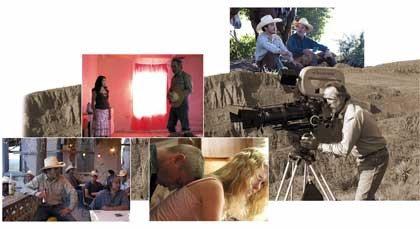Tommy Lee Jones’ new film tells a true-enough tale of the treacherous borderlands
The day is May 20, 1997, and 18-year-old American citizen Esequiel Hernandez Jr. is herding his family’s goats not quite a mile from his home in Radford, Texas. He is carrying a .22-caliber rifle almost old enough to be called a relic. The soft-spoken high-school student often target shoots out here where no one except for passing Mexican drug smugglers is within range. Sometimes foxes and coyote will threaten his goats and, to protect his charges, the rifle comes in handy. Perhaps this is what he was firing at when an M-16 bullet tore through his back, dropping him to the ground.
| Tommy Lee Jones makes his feature-film directorial debut with The Three Burials of Melquiades Estrada, in which he also stars as cattle-ranch foreman Pete Perkins. Barry Pepper, left, plays a violent border patrol officer who murders an illegal immigrant in this grim allegorical tale. |
In the distance, four Marines assigned to the Border Patrol had identified Hernandez as a threat; this despite the fact that they were heavily camouflaged and in deep cover on a drug-interception mission. Hernandez, who probably never knew he was being watched, was shot from behind “in self defense” at 150 yards by Corporal Clemente Banuelos. He bled to death. It was the first murder of an American citizen by a U.S. soldier since the Kent State massacre in 1970, but Banuelos was never charged with a crime.
Tommy Lee Jones’ heart-wrenching testament to the value of human life, The Three Burials of Melquiades Estrada, grew out of the ineffective and degrading geo-political border politics that robbed Hernandez of his future. But Jones, who stepped into the directing chair this time out (his first feature, and the first time he’s directed since the 1995 tele-film The Good Old Boys), is quick to point out his unwillingness to connect his film to the boy’s death.
“I thought what happened to Esequiel would reveal some social tensions that would be useful in shaping a story,” Jones says. “It points to the dangers of ethnocentricity. But I certainly had no intention to make a movie about Esequiel, or to do anything to offend the privacy of his family.”
Nevertheless, the death of Melquiades Estrada (Julio Cedillo), the crime that instigates the film’s story, mirrors Hernandez’s death; one of the few differences is that the murder is committed by violent Border Patrol officer Mike Norton (Barry Pepper), who, after driving out to the middle of nowhere to masturbate to Hustler as he habitually does, reacts to Estrada’s coyote-targeting gunshots by planting a slug in the Mexican’s chest. Later, as Norton stands over Estrada’s quivering body, confused and terrified (after all, what does he do now?), he asks, “Hey, man, you okay?
You bueno?”
“Esequiel’s murder didn’t inspire the movie,” Jones insists. “I recommended that Guillermo `Arriaga, who wrote the screenplay` familiarize himself with the circumstances there, and I gave him transcripts of the congressional hearings report to think over. We were interested in, oh, themes we had common interests in. He wants to do movies about his country and its history and I want to do movies about my country and its history, and along `the Rio Grande` those countries are pretty much the same.”
This shared territory is the backdrop of Three Burials. It is a land where illegal immigrants like Estrada travel to find work with cattle-ranch foremen like Pete Perkins (Jones). The two characters form a powerful bond that culminates when Estrada gives Perkins his horse, which Perkins quickly refuses. “Yours, mine, what’s the difference?” Estrada assures his friend. In exchange, Perkins promises that if Estrada dies in the States, he will take his body back to Jimenez, the village in Mexico where Estrada is from and where his family still resides. When Norton forces Perkins to fulfill that promise, Perkins kidnaps Norton, forces him to disinter Estrada’s remains, and together with the rapidly deteriorating corpse set off for Jimenez with authorities on their tails.
“All of the characters take on an allegorical purpose,” Jones says. “It’s been used before with great success for a wide variety of purposes. Mainly, the idea of a journey wherein Mr. Hero begins in a possibly evil place and is compelled by circumstances to take a long journey through certain other places, some of them life-threatening and some of them mysterious, some of them funny, but all of them arduous until he arrives at a different place having learned something and gained some ability to relate more gracefully to the world around him.”
| “All of the characters take on an allegorical purpose. Mr. Hero begins in a possibly evil place and is compelled by circumstances to take a long journey until he arrives at a different place having learned something.” – Tommy Lee Jones |
Along the path to redemption, Norton, a materialistic masochist full of inexplicable rage and racism, endures the most as he is physically and then mentally broken. His escape attempts leave him dehydrated, lynched, and half-drowned; a snake bite lands him in the care of a woman whose nose he bashed in as she attempted to cross the border into his country (she breaks his nose in return). All along, there’s Estrada’s rotting face staring back at him. The body helps to illustrate the distance between comedy and tragedy as Perkins struggles to protect it from the elements, which means pouring anti-freeze down its throat and even lighting the face on fire to drive away carnivorous ants.
Norton can only marvel at this loyalty; he regretted taking Estrada’s life, maybe even suffered over it, but it’s only through Perkins that he can see Estrada for what he once was: a human being.
Norton is destroyed by the end of the film; even Jones concedes that the character is “pretty-well beat up” by the time it’s over. “Pretty-well beat up” doesn’t do the transformation justice.
Whereas Norton’s journey is the more complex of the two, Perkins’ is nevertheless soaked in unshed tears, especially when a climactic surprise south of the border reveals just how deeply Estrada yearned for the true family ties that, in his own way, he found with Perkins. Jones’ performance won him the Best Actor award at last year’s Cannes Film Festival, and it’s understandable; there is a silent dignity to this old rancher who moves and speaks deliberately, only revealing his all-too-human side in his struggle to keep his promise to Estrada. To watch a drunken Perkins try to lovingly comb the corpse’s dusty hair is a tribute to screenwriter Arriaga’s ability to silently convey suffering, while his minimalist use of dialogue is just as profound. “I don’t want him to die,” Perkins tells a Mexican healer, revealing with six words what human life means to him, but also the promise of redemption one man can offer another when he shows compassion.
It is this, the worth of a single life that must be tallied; it is the worth of lives easily dismissed that must not be forgotten. Jones is a native of Texas, owns and operates a ranch here, and his anger over the conflicts and injustices that occur every day along the Rio Grande is apparent in every frame of Three Burials.
“I’m reluctant to talk about politics,” he says when pressed to discuss current U.S. policy, an uncommon response from a celebrity actor these days. “Any political remarks I might have to make should be rightfully contained in my work. But it’s there. You can see what I think about the environment along the border.” •
By Cole Haddon
















